Seeding Methods
Table of Contents
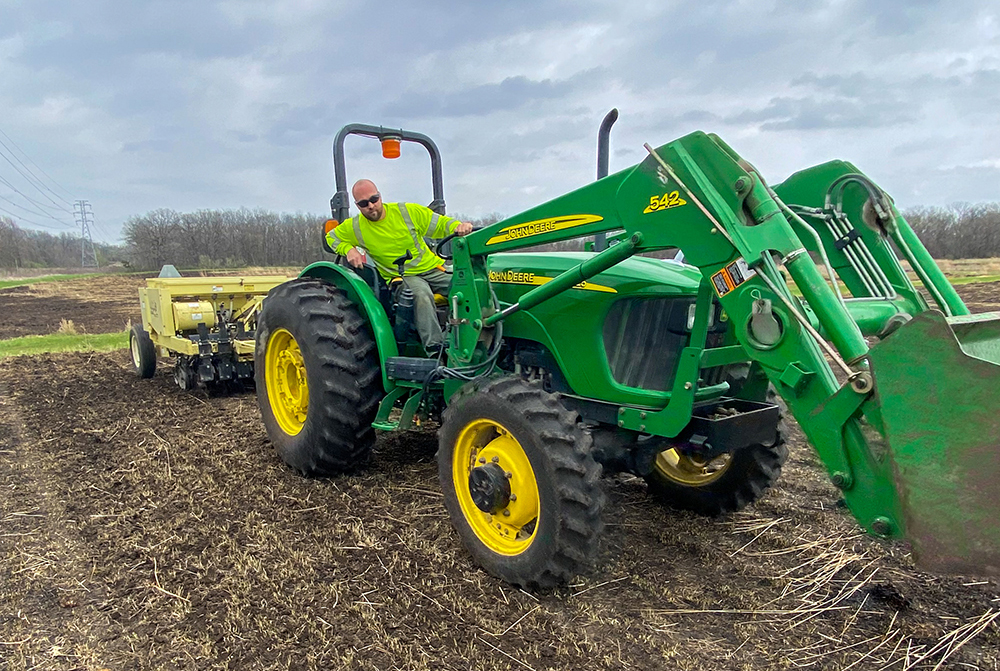
There are three main seeding methods: drill seeding, broadcasting, and hydroseeding. Each method has advantages and disadvantages.
Drill Seeding
Seeding with a native grass drill is the preferred method on level roadsides. Drilling is a quick one-step process that effectively and rapidly establishes native grasses and is cheaper than hydroseeding.
Drilling should be avoided on slopes. At 3:1 or steeper, the drill will try to slide sideways, causing the disc openers to dig in and bury the seed. Projects with silt fences present another challenge, as maneuvering a tractor and drill around these fences is difficult.
Drill Seeding Tips
- Calibrate the drill in the shop and set the seeding rate a little lower than what you actually want, as drills tend to seed higher in the field than calibrated. For example, a drill set at 6.5 lbs./acre might actually seed 8 lbs./acre as it bounces along the ground.
- When planting clean seed with an old drill, use a filler to slow down how quickly the seed leaves the drill, which will prevent overseeding. Planting too much seed on the ground can cause fungus to grow on the seed. Bulk-harvested seed or little bluestem works well.
- For good seed distribution, use the small seed box on the drill for fine seed and the fluffy seed box for grasses, large forb seed, and seed that has not been well-cleaned. Alternatively, sprinkle some forb seed on top of the other seed in the drill’s middle hopper, then add more forbs on top of the other seed every second or third round.
- Do not plant native seed deeper than a quarter of an inch. Most native seeds are small and lack the energy to emerge if planted too deep.
- The trash plow attachment on a native grass drill should just scratch the surface of the soil. If it makes furrows, it is planting too deep.
- For uniform coverage, drill seed at a low rate and go over the area twice. Multiple passes packs the seed, creating more rills (i.e., shallow channels) that hold seeds and interrupt water flow.
- Disconnect the lower end of the drill’s seed tubes to prevent the seed from being buried too deep. This will cause some seeds to land on the soil surface and not be buried in the furrow. Some prefer to unhook every other tube. Others unhook only the tubes coming from the small seed box.
Hydroseeding and Hydromulching
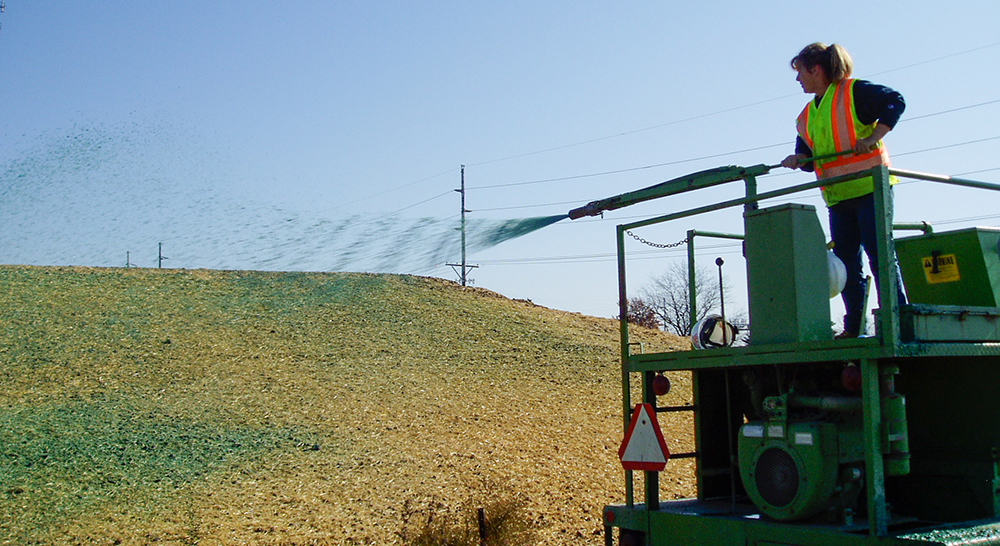
Hydroseeding involves the spraying of a slurry comprised of water, seed, dye that is typically green, and optional fertilizer. It is ideal for bridge approaches, cleanouts, culverts, and wet or steep slopes. In most cases, the entire project can be hydroseeded from the shoulder. Hydromulching involves the same process with mulch added to the slurry. Other advantages to these approaches include:
- Hydromulching reduces soil erosion.
- Hydroseeding eliminates the possibility of seeding too deep.
- Hydromulch that is made colorful with the addition of a dye makes a positive impression on the public.
Filling the hydroseeder takes time, so drilling or broadcasting are usually quicker approaches for larger projects. Other hydroseeding and hydromulching disadvantages include:
- Mulch is expensive and can double the cost of a seeding project.
- The seeding rate is harder to control.
- Hydroseeding and hydromulching are strictly bare-ground applications.
Hydroseeding can be done using either a one-step process or a multi-step process. For the one-step process, the slurry is sprayed onto bare soil. When a one-step process is used, the seeding rate needs to be increased since the seeds are part of a mixture and may not have good soil-to-seed contact. As in other situations, the seeding rate should also be increased on particularly steep slopes. When seeding in the fall, when wildflowers germinate better, some roadside managers will increase the proportion of the seed mix that consists of wildflowers.
For the multi-step process, the cover crop is sprayed first, followed by the seed, and then the mulch is applied on top of the cover crop and seed mixture. An advantage of this method is the improved seed-to-soil contact, as the seed has closer contact with the soil than when mulch is included in the slurry with the seed. However, because the slurry comes out faster without mulch, it may not spread as evenly. Some roadside managers spray the cover crop first, then the seed, and finally, the mulch on top of the cover crop and seed mixture.
Regardless of the process used, following up with straw will help reduce erosion until the cover crop and native seed mixture gets established. Depending on the topography, it may not always be possible to get in and crimp the straw.
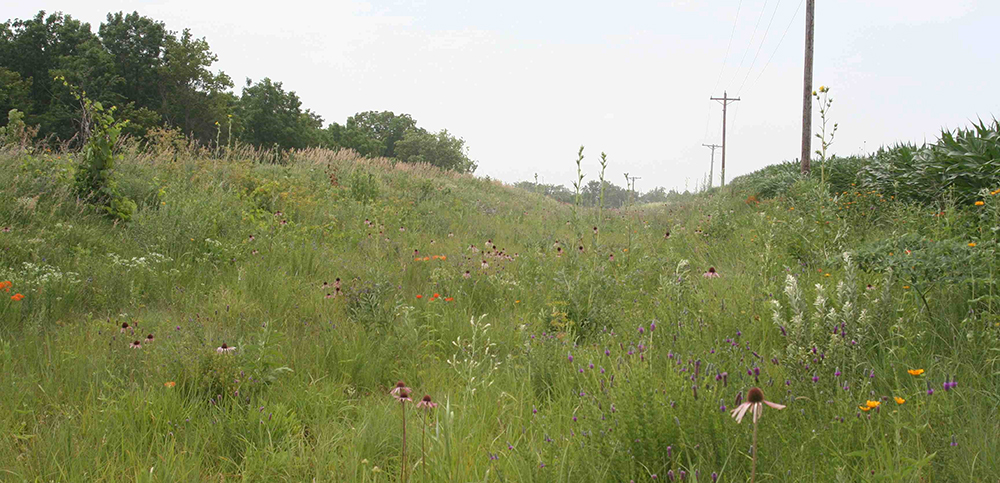
Hydroseeding and Hydromulching Tips
- It is important to include mulch in the mix because without it, the slurry comes out of the hydroseeder too fast, like being sprayed from a garden hose, and it does not spread as well.
- It is best to seed after rainfall, not before. Seed and mulch stick better on moist soil, and moisture will be captured under the mulch. Mulch needs time to settle before it rains.
- The tackifier binds the seed and mulch to the soil surface, keeping them in place so they do not blow or wash away.
- Operating the hydroseeder is loud, so communicative headsets can help the driver and hose operator communicate more easily.
- Increase the seeding rate by 25% to compensate for the seed that is damaged after going through the hydroseeder or gets hung up in the mulch.
- The soil behind larger dirt clods may not get seed coverage. For better coverage, try making two passes, one from each direction. When doing so, seed at a lower rate so your seeding is not double what it would be with one pass. If mulch is used, reduce the flow rate and travel at 1–2 miles per hour. If only water and seed are used, do not exceed 6 miles per hour.
- The minimum recommended size for a hydroseeder is 800 gallons. A 1,500-gallon hydroseeder can cover a third of an acre per load. With a machine of this size, seven 50-lb. bales, or 350 lbs. of mulch per load, yields about 1,000 lbs./acre.
- When driving with a hydroseeder, plan your route carefully, keeping bridge weight limits in mind. A hydroseeder filled with water, mulch, seed, dye, and occasionally fertilizer can weigh up to 10,000 pounds.
- Drafting water out of creeks to fill the hydroseeder can save money. However, be aware of state and federal regulations regarding the transfer of water from one body of water to another. Also, remember that no matter where you release the water, it will be released into a watershed.
- Seed the area farthest from the road first.
- On steep slopes, try to embed the seed by using a more concentrated stream and holding the hydroseeder gun at a sharper angle.
- For the sake of efficiency, most county roadside managers apply seed and mulch in one pass. However, the two-pass method—seed applied first, then hydromulch—results in better establishment since more seed is in direct contact with the soil.
For more information on hydromulching, see “Chapter 6: Erosion Control.”
For more information on hydroseeding, see the Tallgrass Prairie Center’s “Hydroseeding Survey of IRVM Counties in Iowa.”
Broadcast Seeding
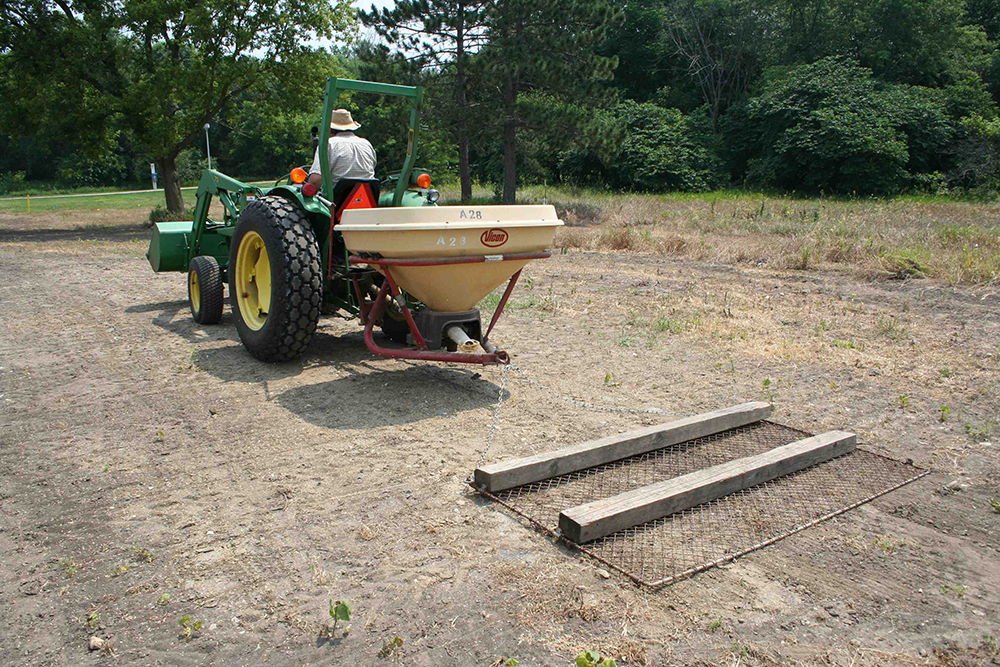
Broadcast seeding is a viable option with clean, non-fluffy, commercially available native seed. This debearded seed can be widely distributed when applied with broadcast seeding equipment.
Broadcast Seeding Tips
- Broadcasting finer-seeded species prevents them from getting buried under too much soil, which may happen if a drill is used.
- When broadcasting very clean seed, some broadcasters can be adjusted down as much as possible.
- When broadcasting fluffy seed, open the gate much wider.
- A broadcast seeder on a 3-point hitch system is more compact than a seed drill and easier to get in and out of ditches.
- If seeding is needed on both sides of a silt fence, broadcasters can be backed up to the fence to sling seed on both sides.
Hand Seeding
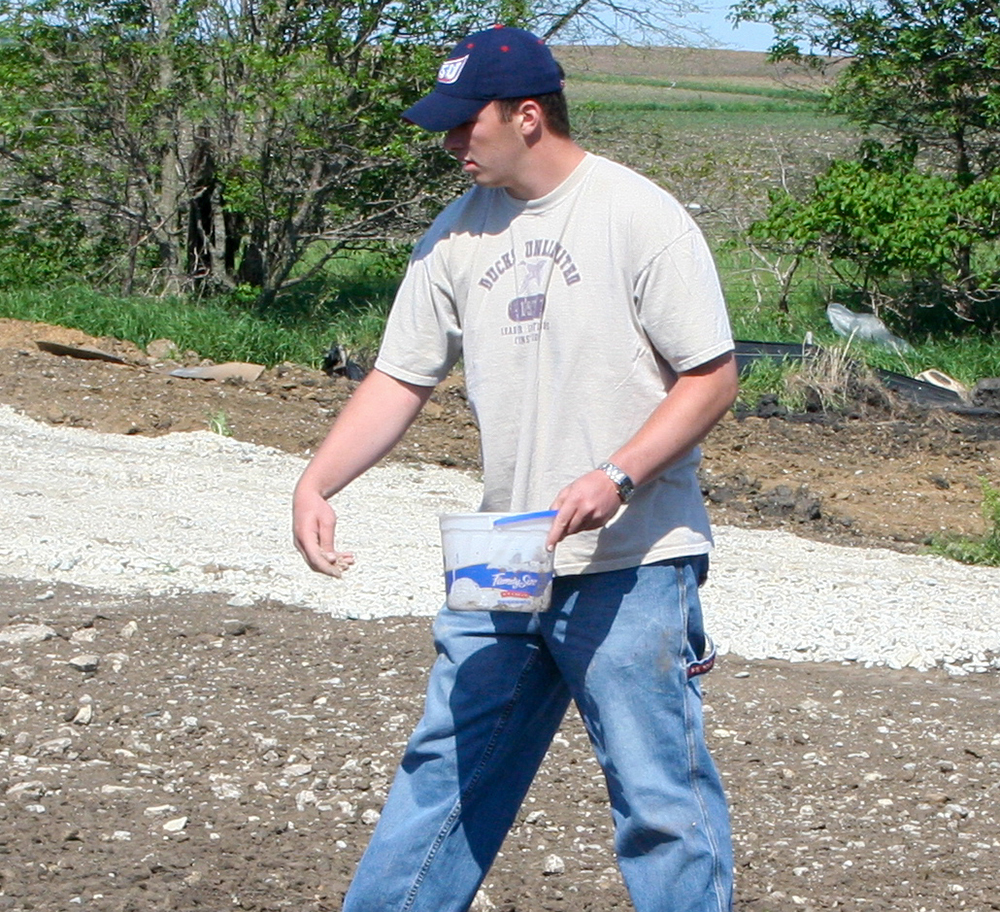
Scattering seed by hand followed by light raking is very effective for smaller sites and prevents fine seed from being planted too deep.
Hand Seeding Tips
- To improve distribution, mix the seed with a carrier. Sand is best, but cat litter or oats can also be used.
- Mix the seed and carrier in a bucket and scatter it over the site by hand.
- Many species planted in wet prairies have fine seeds and should be hand-seeded.
Packing the Seed
Packing seed tightly to the soil ensures a more consistent flow of moisture from the soil to the seed, which results in better germination and seedling survival.
- Packing is most important after broadcast seeding but is always beneficial.
- A 4-foot cultipacker on a 3-point hitch system is very effective and will go places the tractor and drill cannot go, such as slopes that are especially steep.
Drones
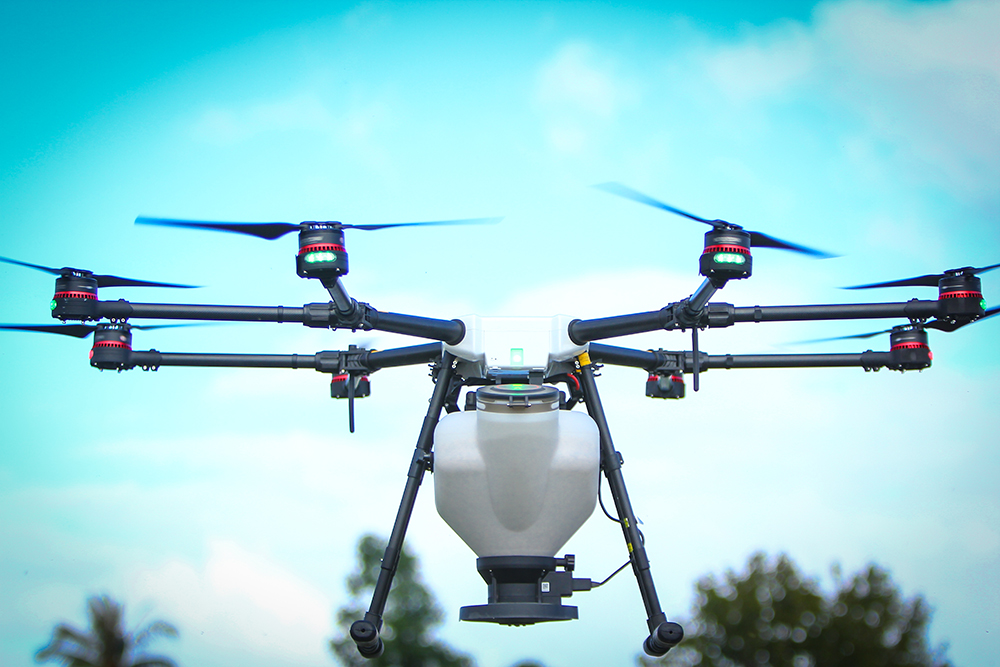
Recently, drone seeding has emerged as another method for seeding cover crops and native seed. However, drone seeding can be pricey. Many Natural Resources Conservation Service (NRCS) offices maintain a list of drone seeding contractors for those interested in learning more.
For roadside managers interested in using a drone for seeding, local agriculture co-ops may have one available to rent, or counties or cities can purchase one. Many resources, such as YouTube videos, explain how to apply native seed using a drone.
Roadside managers who want to operate a drone for seeding must also obtain a drone license. Contact the Federal Aviation Administration to learn more about the required license type.
Roadside Real Talk
Insights from Roadside Managers and Other Professionals
We lightly disc the seedbed before hydroseeding, if possible, cultipack after we seed, then apply mulch for a two-pass method. Hydroseeding is a great method of seeding, but not always necessarily the tool for the job.
—Joe Kooiker, Story County, 2024
When filling a hydroseeder from a creek, know your source. Don’t fill from an area with invasives, such as purple loosestrife. When hydroseeding, be sure to mix seed thoroughly in the water, both initially and periodically, during application. Our Finn hydroseeder can reverse the mechanical agitation, which is helpful.
There’s been some concern about high mulch rates affecting seed germination. I don’t think that’s an issue with large grass seeds, and even small seeds aren’t affected when dormant seeding with a high mulch rate since the mulch softens and breaks down over the winter. The seed can’t germinate if it’s washed away, so use enough mulch to get the job done right.
When mixing seed, we mix 10 acres worth of the fluffy grass, such as sideoats grama, big bluestem, Indiangrass, little bluestem, Canada wild rye, and compassplant and put it in large plastic garbage cans. Then we mix 10 acres worth of the remaining forbs in a large rubber tote and put the two slick grass seeds, rough dropseed and switchgrass, in a third tote. Our fluffy grass rate is around 10 to 12 bulk pounds per acre, our forbs are usually around 3 to 4 pounds per acre, and our slick seed is around 2 pounds per acre. When hydroseeding, we bump these rates an extra 30 to 50 percent at times, depending upon site conditions and current climatic factors. We pretty much always seed with mulch, and we typically use 1,500 pounds of wood fiber mulch per acre. Our 3,300-gallon unit seeds about 0.9 acres pretty well with 1,350 pounds of mulch in it, or 3,600 gallons of material per acre. Some people I know put 1,500 pounds in a 3300-gallon seeder and seed a full acre, but we always seem to run a little short doing it that way.
—Jim Uthe and James Devig, Dallas County, 2024
Filling near the site with a trash pump has drastically improved the efficiency of the process. We mounted the pump on the seeder, so we simply drop a fill line into the water and turn on the pump.
—Josh Brandt, Cerro Gordo County, 2010
We have better germination with lighter hydromulch rates of 400 to 500 pounds per acre.
—Dave Sedivec, Chickasaw County, 2010
Don’t trust your drill to meter your seed. Know your acreage and equally distribute the seed.
—Wes Gibbs, Jones County, 2024
When hydroseeding, you initially have to know how much area you are covering with a full load. With our Finn T-90, I cover a third of an acre per load. That may be more than is recommended for that size of a machine, but it means fewer loads per job and is quicker to finish. With our 22-foot wide ROWs on average, we travel 660 feet to make that one-third of an acre. With practice, you can become pretty accurate—arriving at 660 feet with an empty hydroseeder. If we use UNI’s recommended rates, then big bluestem at 1.5 pounds per acre, for example, uses 0.5 pounds per load. We weigh out the amount of each species needed for one-third of an acre and put it in one bag ahead of time. Then, we can just dump the bag in each load. This holds true for the nurse and temporary crops as well.
—Linn Reece, Hardin County, 2011


